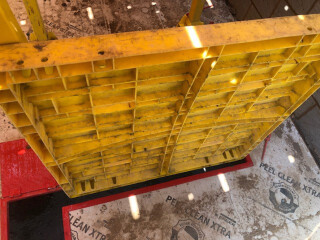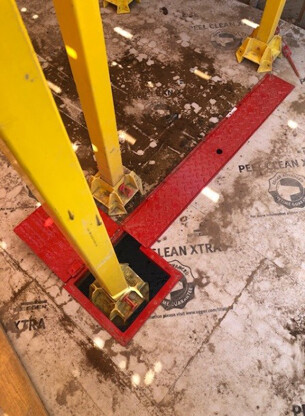In January this year, Brighton magistrates handed down a suspended prison sentence to a company director for serious safety breaches that led to a subcontractor getting crushed under a stack of plasterboard sheets.
The incident, which occurred in April 2019, was a classic case of couldn’t-care-less ignorance and incompetence. But it also highlighted a systemic problem: the difficulty of manually handling large-format board products on site. In this case, the plasterboard had been stacked carelessly against an unsecured ladder and the site operatives were sliding the sheets – each weighing 32kg – up to colleagues on the floor above.
When the HSE investigated the incident, which left a worker with a fractured pelvis, the inspectors found that there was no safe system of work in place. The stairwell openings were not guarded and they were partially spanned with scaffold boards resting on insecure scaffold poles.
This article was first published in the March 2021 issue of The Construction Index magazine. Sign up online.
The employer, Siamek Samyani, was sentenced to 20 weeks in prison (suspended for 12 months), fined £3,400 and ordered to pay costs of £600.
Of course this incident only came to light because someone was injured; it’s no secret that similar incidents and near-misses are frequently encountered on sites where bulky materials have to be lifted manually between floors.
By sheer coincidence, just days after this court case was reported in the media, Protec – a product manufacturer headquartered in Adlington, Cheshire – went to press with a glossy brochure for a new range of products; products that would have helped prevent this very accident.

Protec’s core product is a range of temporary protective sheeting designed to prevent damage to finishes and provide anti-slip surfaces during the construction process. This new range represents a departure for the company as these are purely safety products.
Dubbed ProSafe, the range includes a temporary handrail system for guarding against falls through unfinished stairwells; a ladder-lock to prevent unauthorised use of fixed ladders; and three products designed to facilitate the safe transfer of products and materials between floors.
The ladder hatch, safety-deck hatch and plasterboard hatch are simple products – and not entirely unique, as Protec’s head of commercial, Greg Dunne, admits. “There have been various similar products knocking about for a while, whether made out of plywood, not reusable or whatever. Things like the ladder hatch – there have always been formulations of this concept,” he says.
“But if you want something completely brand new you would single-out the safety-deck hatch. That absolutely is our brand and completely brand-new.”
The safety-deck hatch was developed a year ago from the company’s plasterboard hatch, which has now been available for about 18 months. The products are made from steel checker-plate and are, in essence, simply hinged trap-doors shaped to allow specific items to be posted through them – just like posting a letter through a letterbox.
Development of the new range has been led by Protec’s product development manager Emma Ward. Previously working in sales, Ward returned to work after time off for maternity leave and effectively created a new role for herself based on customer liaison.
“My job’s about creating relationships with customers to really understand what their challenges are on site,” she says. And it didn’t take her long to identify challenges concerning manual handling.
A very large proportion of Protec’s business is with the house-building industry and it was one of the UK’s leading house-builders that alerted Ward to a pressing need for a new way of passing sheets of plasterboard from one floor to another.

It is common practice simply to carry the boards up the staircase one-by-one – an awkward and potentially risky operation. Not only do you risk damaging the board and the walls, but even the smallest standard size – say 1,800mm x 900mm – is tricky to man-handle up a staircase.
This particular client – one of the top five UK house-builders – had an incident in which a site worker, carrying a sheet of plasterboard upstairs, fell and broke his back. “They immediately introduced a blanket health & safety rule: no walking up staircases with a sheet of plasterboard,” explains Dunne. “So then people were saying ‘well how do we get them up to the top floor?’
“And what they did was pass plasterboard through the window openings instead. Can you imagine that?” he adds.
Ward worked with the client’s construction manager to perfect the design for the new plasterboard hatch. The steel unit is installed over an opening cut into the chipboard decking of the suspended floor. Presenting a long, narrow slot with a hinged cover, the hatch allows individual boards to be lifted up from below while avoiding any risk of trips or falls.
This design was also the basis of the new safety-deck hatch, developed last year. “It’s a reformulation of the plasterboard hatch with a box added so you can get the supports up as well as the deck units,” explains Dunne.
Safety decks are widely used in the house-building industry to provide a working platform inside the building. Comprising deck units and support legs, usually with proprietary edge protection, these systems are carried up from floor to floor as work progresses.
Just like the plasterboard hatch, the new safety-deck hatch allows these components to be handed up safely through a protected opening in the floor.
Hatches designed for this purpose already existed, but all of them had openings large enough for a person to climb through. They rely upon operatives opening and closing the hatch when delivering the decking components. If left open, these hatches create an unguarded void that someone can fall through.

The Protec hatch has a slot for the safety-deck leg and a longer separate slot for the deck itself, with covers hinged to a frame which can be opened separately or both together.
The hatch is left in until pre-paint so that other components such as architraves, skirting boards and pipework can also be passed through safely. The design has been approved by the manufacturer of the chipboard flooring and has received the go-ahead with a detail to refit the floor after the hatch is removed.
The ProSafe range, now illustrated in Protec’s glossy new brochure, is actually just the formalisation of a largely reactive, piecemeal product development process spanning many months.
Driven by client demand, the products been designed and supplied more or less to order: “They have been available and we’ve kept them in stock – but we haven’t marketed them until now,” explains Ward.
The house-builder that worked with Prosafe to develop the safety-deck hatch now uses it on every site in one of its regional divisions, says Ward. And Dunne says that other leading house-builders are also showing some enthusiasm for the product.
This article was first published in the March 2021 issue of The Construction Index magazine. Sign up online.
It’s just a shame that it’s all come a bit too late for a certain site operative who spent weeks recovering from a shattered pelvis…
Got a story? Email news@theconstructionindex.co.uk


